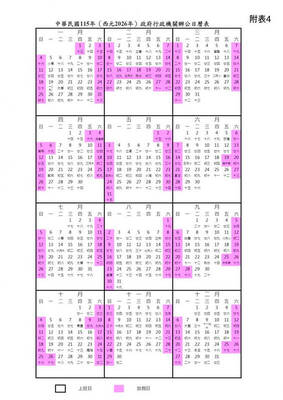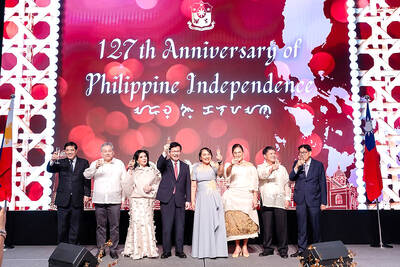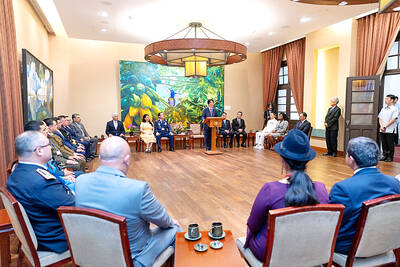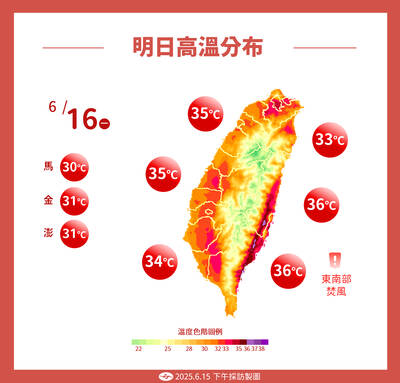The National Communications Commission’s (NCC) policy on telecoms pricing has seen it lock horns with telecoms carriers, which are against the commission’s decision to lower rates on April 1.
The NCC said it had followed administrative procedure and gathered opinions at public hearings and meetings with telecoms company executives before it formulated its policy. Under the Telecommunications Act (電信法), telecoms carriers must hand in their adjusted price rate plans by March 12 or they will face a penalty of between NT$300,000 and NT$5 million (US$156,000).
The NCC said it aims to lift the price-cap policy on the retail rates and regulate wholesale call termination rates. Article 26 of the Telecommunications Act authorizes the NCC to cap retail rates, meaning telecoms carriers cannot raise the rates above the cap, only lower them.

PHOTO: CNA
The article also allows the NCC to set an adjustment coefficient, known as the “x value,” which determines the range of reductions in any given year. The article was enforced for the first time in 2006, when the NCC decided to set the adjustment coefficient at 4.88 percent. The commission also ruled that the same coefficient would be applied consecutively for three years from 2007 to last year.
Back then, the NCC ruled that the price-cap method would only apply to fixed network services and second-generation mobile phone network (2G) services. Most carriers only dropped rates for those paying low monthly fees but high per-minute charges, as well as those using prepaid cards.
Users paying higher monthly fees, as well as those using 3G services, were practically unaffected by the implementation of the policy.
This time, however, rates for 2G, 3G and fixed network services must be cut. The percentage of reduction is greater than previously as well — 5.686 percent, after factoring in the inflation, for fixed network services and 5.87 percent for mobile communication services.
Under the NCC’s plan, an estimated 41 million account holders are expected to benefit from the execution of the policy. Starting in April, those paying about NT$1,000 per month will pay NT$30 to NT$40 less.
Telecoms carriers, however, claim that the new policy, once executed, will bring a “tsunami” to the nation’s telecommunications industry.
The Telecommunication Industry Development Association (TTIDA) estimated their losses may exceed NT$37 billion. The association said the reduced revenues would force the carriers to curtail their investments in new technologies and innovative services. The association also argues that telecoms services is a perfect competitive market, as carriers have launched many different promotional plans to attract customers, including allowing customers to call for free if both the caller and the recipient are with the same carrier.
The association wants the government to abandon the price-cap method and let market mechanisms determine reasonable retail prices.
NCC spokesperson Chen Jeng-chang (陳正倉), however, disagreed with the association’s claims.
“It [the telecoms services market] is actually an oligopoly, where you have a few carriers dominate the market,” Chen said. “Telecoms companies are able to gain huge profits because they have special licenses handed out by the government. They say they have never raised rates. They have never lowered rates either. All they offer their customers are promotional rates.”
Chen said it is only reasonable for telecoms carriers to return some of the profits to their customers. Lower rates, he argued, would encourage mobile phone use and in turn help generate extra revenues.
While the NCC reached a consensus to lower rates, commissioners differed on the level of competition between the carriers. Commissioner Hsieh Ching-nan (謝進男) said the government’s tax revenues shrunk by NT$265 billion last year because of the global economic downturn, but the carriers still managed to generate net profits of NT$66.8 billion. Not only did the carriers maintain their profitability amid the economic downturn, Hsieh said they also continued to produce solid profits after they were asked by the NCC to reduce rates.
“To say that the telecommunications market is a perfectly competitive one would be a bit far-fetched,” Hsieh said.
While Hsieh considered telecoms services an imperfect market, he said competition among different technologies would help drive down retail prices.
“Some may think that CHT [Chunghwa Telecom] has a monopoly in asymmetric digital subscriber line [ADSL] services, but it is now competing with cable television service providers, who can also offer almost the same quality of broadband services via cable modem. The policy should be executed in a way that allows CHT to remain competitive,” Hsieh said.
Hsieh, however, cautioned on the regulation of wholesale termination rates.
“The commission must have well-rounded complementary measures in place first, otherwise profits will simply transfer from one telecoms carrier to another,” he said.
Commissioner Liu Chorng-chien (劉崇堅), on the other hand, said 2G services had to compete with low-power mobile communications services (PHS) and 3G services. Average revenue per minute for 2G services has dropped and the charge for 2G services was lowered from NT$7.34 per minute to NT$5.94 per minute. The NCC ought to stop using the price-cap method to regulate retail prices of 2G services, he said.
Liu also argued that it was unreasonable for the NCC to use a higher coefficient for 3G services than for 2G services, because the market for 3G services is now more competitive than for 2G services. The coefficient for a relatively more competitive service should be lower, he said.
The nation’s 2G service providers are CHT, Taiwan Mobile and Far EasTone Telecommunications. Those three operators, along with Vibo Telecom and Asia-Pacific Telecom, also run 3G services.
The NCC considers CHT, Taiwan Mobile and FarEasTone to be the three dominant market leaders.
The Telecommunications Act requires 2G service providers to pay license fees that equal 2 percent of their revenues every year, whereas 3G service providers were only obligated to pay a fee when they applied for a license.
NCC statistics show that the volume of traffic for both 2G and 3G services topped 30.2 billion minutes when the adjustment coefficient was first set in 2007. That figure increased to 35.8 billion minutes last year. While the traffic volume of 2G and 3G services increased, the revenues generated from voice communications actually decreased. Statistics showed revenues slid from NT$213.5 billion in 2007 to NT$212.1 billion in 2008. Revenues slightly increased to NT$212.3 billion last year.
Meanwhile, the revenues generated by 3G service have shot up from NT$58 billion in 2007 to NT$130 billion last year, while revenues generated by 2G services fell drastically from NT$154.8 billion in 2007 to NT$82 billion.
Professor Jason Lin (林一平) of the electrical engineering department at National Chiao Tung University said telecoms companies would survive after the mandatory price reduction is implemented.
“The question you have to ask is whether it [the policy] simply cuts out a piece of ‘fat’ from the telecoms companies or actually cuts to the bone.” Lin said. “I don’t think it cuts to the bone yet.”
Lin, however, said the reaction of the carriers was understandable and suggested that the NCC communicate its policy more calmly and rationally. The carriers should know by now that voice communications services are no longer profitable, he said, adding that they should seek to generate traffic by creating value-added services, such as electronic books.
Lin Tsung-nan (林宗男), professor of the electrical engineering department at National Taiwan University, said the policy simply made rates more reasonable.
“They [the telecoms carriers] claim they need to charge more for 3G services because customers can use it to watch videos and enjoy other innovative services,” Lin Tsung-nan said. “In the past five years, a majority of their revenues still came from voice communications. They did not introduce any exciting new services.”
He also said regulating wholesale termination rates was the right direction to go.

Taiwan is to have nine extended holidays next year, led by a nine-day Lunar New Year break, the Cabinet announced yesterday. The nine-day Lunar New Year holiday next year matches the length of this year’s holiday, which featured six extended holidays. The increase in extended holidays is due to the Act on the Implementation of Commemorative and Festival Holidays (紀念日及節日實施條例), which was passed early last month with support from the opposition Chinese Nationalist Party (KMT) and Taiwan People’s Party. Under the new act, the day before Lunar New Year’s Eve is also a national holiday, and Labor Day would no longer be limited

Taiwan is to extend its visa-waiver program for Philippine passport holders for another year, starting on Aug. 1, Minister of Foreign Affairs Lin Chia-lung (林佳龍) said on Friday. Lin made the announcement during a reception in Taipei marking the 127th anniversary of Philippine independence and the 50th anniversary of the establishment of the Manila Economic and Cultural Office (MECO) in Taiwan, the Ministry of Foreign Affairs said. The decision reflected Taiwan’s commitment to deepening exchanges with the Philippines, the statement cited Lin as saying, adding that it was a key partner under the New Southbound Policy launched in 2016. Lin also expressed hope

Costa Rica sent a group of intelligence officials to Taiwan for a short-term training program, the first time the Central American country has done so since the countries ended official diplomatic relations in 2007, a Costa Rican media outlet reported last week. Five officials from the Costa Rican Directorate of Intelligence and Security last month spent 23 days in Taipei undergoing a series of training sessions focused on national security, La Nacion reported on Friday, quoting unnamed sources. The Costa Rican government has not confirmed the report. The Chinese embassy in Costa Rica protested the news, saying in a statement issued the same

Temperatures in New Taipei City’s Sindian District (新店) climbed past 37°C yesterday, as the Central Weather Administration (CWA) issued heat alerts for 16 municipalities, warning the public of intense heat expected across Taiwan. The hottest location in Taiwan was in Sindian, where the mercury reached 37.5°C at about 2pm, according to CWA data. Taipei’s Shilin District (士林) recorded a temperature of 37.4°C at noon, Taitung County’s Jinfeng Township (金峰) at 12:50 pm logged a temperature of 37.4°C and Miaoli County’s Toufen Township (頭份) reached 36.7°C at 11:40am, the CWA said. The weather agency yesterday issued a yellow level information notice for Taipei, New